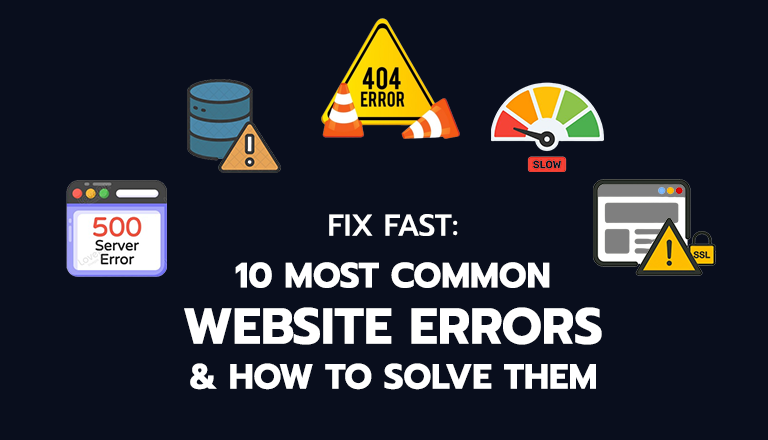If you are a new website owner, being aware of common errors is crucial, as they inevitably crop up over time.
Websites, like any intricate system, are prone to glitches that can frustrate users and damage your reputation. Understanding how to quickly fix errors is key to maintaining a smooth site experience.
Often, you’ll encounter an HTTP error message – essentially a note from the server that something has gone wrong. It may be a mistake on your end, but frequently the cause is on the website’s side.
Each error type has a dedicated HTTP status code. For instance, the well-known 404 error appears when trying to access a non-existent page.
In this guide, we will walk through the top 10 most frequent website errors, their causes, impacts, and most importantly, how to resolve them.
1. HTTP 404: Page Not Found
The HTTP 404 error, commonly known as ‘Page Not Found,’ is like hitting a dead end on the internet highway.
It occurs when a user tries to reach a page on your website that simply doesn”t exist. This error can be due to various reasons, such as a deleted page, a broken link, or a mistyped URL.
Studies show that over 90% of users will leave a website after encountering a 404 error.
What Causes HTTP 404 Errors?
- Broken or outdated links.
- Incorrect URL entered by the user.
- Deleted or moved web pages without proper redirection.
Impact Of 404 Errors:
- Frustrates users, leading to a poor user experience.
- Negatively impacts search engine ranking.
- Can result in decreased web traffic.
How To Fix HTTP 404 Errors:
- Regularly check for broken links using tools like Google Webmaster.
- Implement proper redirects for moved or deleted pages.
- Customize your 404 page with helpful links or a search bar to improve user experience.
2. DNS Errors
DNS (Domain Name System) errors occur when your browser can’t translate the website’s domain name into an IP address, a crucial step for accessing any website.
They can be particularly perplexing because the website itself might be functioning perfectly, but still remains unreachable.
What Causes DNS Errors?
- Issues with the DNS server.
- Incorrect DNS settings.
- Expired domain registrations.
Impact Of DNS Errors:
- Complete inaccessibility of the website.
- Potentially prolonged downtime, leading to lost traffic and revenue.
- Damage to the website”s reputation and search engine rankings.
How To Fix DNS Errors:
- Verify that your domain name is correctly registered and hasn’t expired.
- Check your DNS server settings and ensure they are correctly configured.
- Use a reliable DNS provider to minimize downtime and ensure stability.
3. HTTP 500: Internal Server Error
An HTTP 500 error, known as ‘Internal Server Error,’ is the digital equivalent of a ‘Something went wrong’ message. It’s a generic error indicating that something has gone awry on the website’s server, but the server can’t pinpoint the specific issue.
These errors are particularly challenging because they offer little information about their cause.
What Causes HTTP 500 Errors?
- Server-side scripting issues.
- Permission errors.
- Corrupted .htaccess files.
Impact Of HTTP 500 Errors:
- Renders the website unusable, affecting user experience.
- Impacts site reliability and user trust.
- Can lead to a drop in search engine rankings if not resolved quickly.
How To Fix HTTP 500 Errors:
- Check server logs to identify the root cause of the error.
- Ensure all file permissions are set correctly.
- Verify that your .htaccess file is not corrupted and is properly configured.
4. Database Errors
Database errors occur when there’s an issue connecting to or interacting with the website’s database, which is crucial for storing and retrieving content. Commonly seen in dynamic websites with content management systems, these errors can cripple a website”s functionality.
What Causes Database Errors?
- Incorrect database connection settings.
- Corrupted database tables.
- Overloaded database servers.
Impact Of Database Errors:
- Can lead to complete website inaccessibility.
- Loss of data integrity and potential data loss.
- Adversely affects user experience and trust.
How To Fix Database Errors:
- Ensure your database connection settings are correct.
- Regularly backup your database to prevent data loss.
- Optimize your database and server performance to handle traffic efficiently.
5. JavaScript Errors
JavaScript is a programming language used to add interactivity and dynamic effects to websites. It allows for features like responsive menus, interactive maps, animations, and more.
JavaScript code is executed in the browser. Like any code, JavaScript can sometimes have errors that prevent it from running properly which can lead to broken layout on pages.
What Causes JavaScript Errors?
- Syntax errors in the code.
- Conflicts with other scripts or outdated libraries.
- Browser incompatibilities.
Impact Of JavaScript Errors:
- Breaks interactive features, degrading the user experience.
- Can lead to layout issues and unresponsive elements.
- Affects website performance and SEO rankings.
How To Fix JavaScript Errors:
- Regularly review and test your JavaScript code for errors.
- Keep your libraries and frameworks updated.
- Test your website across different browsers to ensure compatibility.
6. Slow Site Speed / Performance
Slow website performance can be a frustrating experience which can drive away visitors. This issue arises when a website takes too long to load, often leading to higher bounce rates and decreased user satisfaction.
In an age where speed is everything, ensuring your website loads quickly is vital for maintaining user engagement and search engine rankings.
What Causes Website Performance Lag?
- Large, unoptimized images or files.
- Inefficient code or excessive use of scripts.
- Poor web hosting services or server overload.
Impact Of Slow Website Performance:
- Leads to a poor user experience and increased bounce rates.
- Negatively impacts SEO and search engine rankings.
- Can result in lost conversions and revenue.
How To Fix Website Performance Issues:
- Optimize images and files for faster loading. Check this article for useful tips: Supercharge Slow Websites: Simple, Effective Speed Boosts
- Minimize HTTP requests and streamline your website”s code.
- Choose a reliable hosting provider and consider a content delivery network (CDN) like Cloudflare for better distribution of resources.
7. WordPress Configuration Errors
WordPress configuration errors typically occur when setting up or making changes to a WordPress site and can range from minor inconveniences to major operational issues.
Given WordPress’s popularity, understanding these errors is crucial for a large portion of website owners.
What Causes WordPress Errors?
- Incorrect file permissions.
- Incompatible plugins or themes.
- Errors in the wp-config.php file.
Impact Of WordPress Errors:
- Can cause your website to be partially or entirely non-functional.
- Security vulnerabilities leading to potential breaches.
- Impacts user experience and site credibility.
How To Fix WordPress Errors:
- Ensure file permissions are correctly set.
- Regularly update and test compatibility of your plugins and themes. Make sure to setup a staging site to test these updates first.
- Review and correct any mistakes in the wp-config.php file.
8. Invalid Security Certificates
Invalid Security Certificates are like expired IDs for websites. They occur when a website”s SSL/TLS certificate, crucial for establishing secure connections, is not correctly set up or has expired. These errors can cause browsers to warn users against visiting your site, potentially driving traffic away and harming your credibility.
What Causes Certificate Errors?
- Expired SSL/TLS certificates.
- Certificates not issued by a trusted authority.
- Mismatched domain names on the certificate.
Impact Of Security Certificate Errors:
- User trust and site credibility are significantly affected.
- Can lead to decreased traffic and potential loss of revenue.
- Impacts website”s search engine rankings.
How To Fix Security Certificate Errors:
- Regularly monitor and renew your SSL/TLS certificates before they expire.
- Ensure your certificate is issued by a recognized authority. You can buy a free SSL from LetsEncrypt.
- Verify that the certificate matches your domain name.
9. 503 Service Unavailable
A 503 Service Unavailable error is like a closed sign on a store door. It indicates that the server is currently unable to handle the request due to temporary overloading or maintenance. This error is often temporary, but it can be frustrating for users attempting to access your site.
What Causes 503 Service Unavailable?
- Server overload or maintenance.
- Issues with a web host provider.
- Malicious attacks such as DDoS (Distributed Denial of Service).
Impacts Of 503 Service Unavailable:
- Temporary inaccessibility of the website.
- Potential loss of traffic and user trust if the issue persists.
- Affects site reliability and reputation.
How To Fix 503 Service Unavailable:
- Check if your web server or hosting service is undergoing maintenance.
- Optimize your server to handle high traffic volumes efficiently.
- Protect your site against DDoS attacks with appropriate security measures. Check this article to know more about such attacks: Defend Your Site: 12 Common Website Security Attacks
10. Hacked Website: Mass Defacements
A hacked website, particularly one suffering from mass defacements, is akin to vandalism of your digital property. This occurs when hackers gain unauthorized access and alter the visual appearance of your website, often replacing content with their own messages or images.
Such attacks not only disrupt normal operations but can also damage your brand’s reputation and user trust.
What Causes Website Defacements?
- Weak security protocols or unpatched vulnerabilities.
- Insecure passwords or compromised user credentials.
- Outdated software or plugins.
Impact Of Website Defacements:
- Leads to a loss of credibility and user trust.
- Can result in temporary or permanent loss of data.
- Harms search engine rankings and online visibility.
How To Fix Hacked Websites:
- Regularly update and patch your website and its components.
- Implement strong password policies and multi-factor authentication.
- Regularly backup your website to restore it quickly in case of an attack.
Conclusion
Dealing with website errors can feel like finding your way through a maze – confusing sometimes, but kind of fun when you find the exit.
By understanding these common issues and implementing the suggested fixes, you’re taking proactive steps towards creating a more robust and resilient website.
Remember, in the digital world, a well-maintained website is your strongest asset. Stay vigilant, stay updated, and let your website be a reflection of your dedication to excellence and security.
FAQ Section
- How often should I check for website errors?
It’s best to conduct regular checks for website errors, ideally on a weekly basis. This becomes even more important after you’ve done any big updates or changes. Staying on top of this helps you catch and fix problems early, keeping your site running smoothly and ensuring a great experience for your users. - Are automated tools effective in detecting website errors?
Yes, automated tools are invaluable for spotting a range of website issues, from broken links to security gaps or slow performance areas. They’re really good at what they do, but it’s also smart to do some manual checks yourself to make sure nothing gets missed. - Can website errors affect my SEO rankings?
Yes, they can. Website errors, particularly those affecting user experience like slow load times, broken links, or security warnings, can negatively impact your SEO rankings. Since search engines love sites that users find helpful and safe, keeping yours error-free is key for SEO wins. - Is a technical background necessary to fix website errors?
While having a technical background is beneficial, many common website errors can be resolved with the right tools and guidance. Resources and tutorials are widely available, making it possible for non-technical website owners to address many issues independently. - What is the most critical error to fix immediately?
Security-related errors are the most critical and should be addressed immediately. This includes issues like security certificate errors, vulnerabilities to hacking, or malware infections. These not only compromise user data but also significantly damage your website”s credibility. - Can website errors lead to data loss?
Certain errors, especially those related to server or database issues, can lead to data loss. Making regular backups is key to protecting against losing data. It’s also really important to have strong data management and security measures to help lower this risk.






Share Your Thoughts: